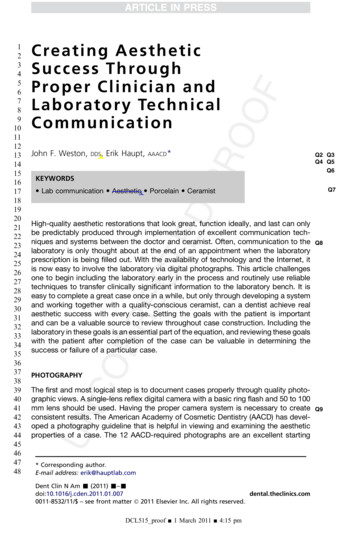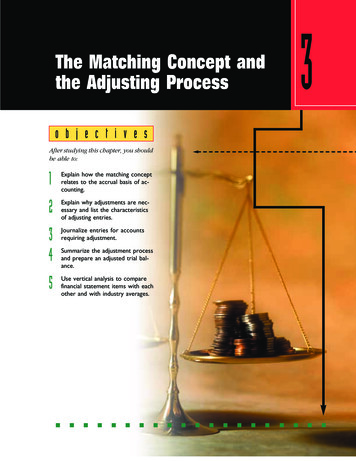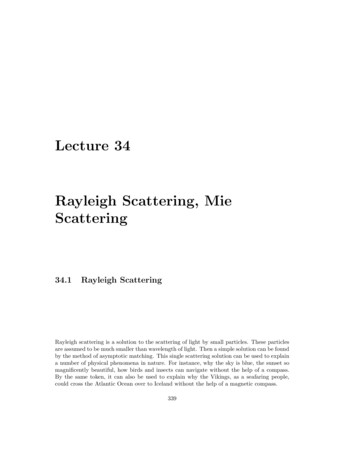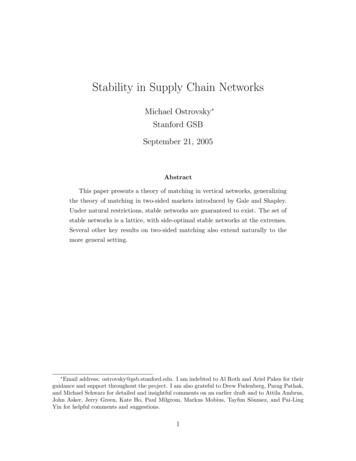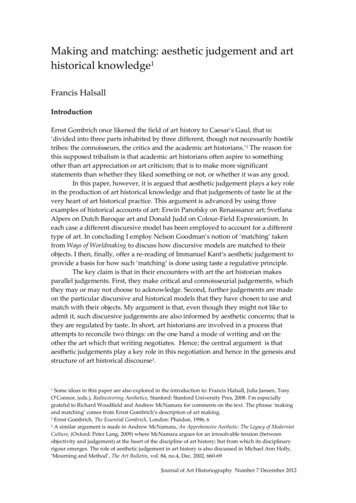
Transcription
Making and matching: aesthetic judgement and arthistorical knowledge1Francis HalsallIntroductionErnst Gombrich once likened the field of art history to Caesar’s Gaul, that is:‘divided into three parts inhabited by three different, though not necessarily hostiletribes: the connoisseurs, the critics and the academic art historians.’2 The reason forthis supposed tribalism is that academic art historians often aspire to somethingother than art appreciation or art criticism; that is to make more significantstatements than whether they liked something or not, or whether it was any good.In this paper, however, it is argued that aesthetic judgement plays a key rolein the production of art historical knowledge and that judgements of taste lie at thevery heart of art historical practice. This argument is advanced by using threeexamples of historical accounts of art: Erwin Panofsky on Renaissance art; SvetlanaAlpers on Dutch Baroque art and Donald Judd on Colour-Field Expressionism. Ineach case a different discursive model has been employed to account for a differenttype of art. In concluding I employ Nelson Goodman’s notion of ‘matching’ takenfrom Ways of Worldmaking to discuss how discursive models are matched to theirobjects. I then, finally, offer a re-reading of Immanuel Kant’s aesthetic judgement toprovide a basis for how such ‘matching’ is done using taste a regulative principle.The key claim is that in their encounters with art the art historian makesparallel judgements. First, they make critical and connoisseurial judgements, whichthey may or may not choose to acknowledge. Second, further judgements are madeon the particular discursive and historical models that they have chosen to use andmatch with their objects. My argument is that, even though they might not like toadmit it, such discursive judgements are also informed by aesthetic concerns; that isthey are regulated by taste. In short, art historians are involved in a process thatattempts to reconcile two things: on the one hand a mode of writing and on theother the art which that writing negotiates. Hence; the central argument is thataesthetic judgements play a key role in this negotiation and hence in the genesis andstructure of art historical discourse3.Some ideas in this paper are also explored in the introduction to: Francis Halsall, Julia Jansen, TonyO’Connor, (eds.), Rediscovering Aesthetics, Stanford: Stanford University Pres, 2008. I’m especiallygrateful to Richard Woodfield and Andrew McNamara for comments on the text. The phrase ‘makingand matching’ comes from Ernst Gombrich’s description of art making.2 Ernst Gombrich, The Essential Gombrich, London: Phaidon, 1996, 63 A similar argument is made in Andrew McNamara, An Apprehensive Aesthetic: The Legacy of ModernistCulture, (Oxford: Peter Lang, 2009) where McNamara argues for an irresolvable tension (betweenobjectivity and judgement) at the heart of the discipline of art history; but from which its disciplinaryrigour emerges. The role of aesthetic judgement in art history is also discussed in Michael Ann Holly,‘Mourning and Method’, The Art Bulletin, vol. 84, no.4, Dec. 2002, 660-691Journal of Art Historiography Number 7 December 2012
Francis Halsall Aesthetic Judgement and Art Historical KnowledgeAesthetics and KunstwissenschaftIn his ‘experiment in art writing’, The Sight of Death the art historian T.J. Clarkreflected upon what it means to translate the personal experience of looking into thepublic realm of art historical language. The book is a series of diary entriespresenting the abstract thoughts, meditations and occasional poems that emergedfrom a sustained encounter with two paintings by Poussin, Landscape with a ManKilled by a Snake and Landscape with a Calm (which, in 2000, were both in the GettyMuseum in Los Angeles.) The result is a meandering text in which he describes theconditions under which the image was encountered including the weather andparticular effects of light.The ethos of the book is summed up by Clark’s somewhat odd claim that:‘And yes, I do think a good poem about Poussin would be the highest form ofcriticism.’4 Clark claims at one point that he is ‘flinching from the business ofputting these weights and movements into words.’5 And perhaps one reason for this‘flinching’ is how the project runs counter to received art historical method ofensuring epistemological certainties.It is not until 57 pages in that an art historical fact appears, and then with acaveat: ‘The Louvre catalogue says – at last a fact, and first facts are alwaysscandalous – that early on in Rome Poussin caught syphilis and was never properlycured.’6Clark’s claim that a poetics of the images would contribute to our knowledgeof them seems initially at odds with the art historical tradition of Kunstwissenschaft.Clark’s project disrupts received notions of art historical scholarship because he isunapologetic in allowing the irruption of aesthetics into the writing of art. Howeverthe argument here is that what Clark is doing is what all art historians do; namely aprocess of making and matching in which methods for describing and reconstructingworks of art in present contexts are judged to be appropriate to those works.A genealogical investigation into the foundations of institutional art historyreveals that it has a dialectical and very uneasy relationship with aesthetics7.Modern art history was systematised in German language art discourse as ascientific method or Kunstwissenschaft. In German-language Kunstwissenschaft, isdistinct from Kunstgeschichte (stories or histories of art), the former sharingPositivism’s concerns with the possibility of objectivity of statements.T.J. Clark, The Sight of Death, London: Yale University Press, 2006, 53T.J. Clark, The Sight of Death, London: Yale University Press, 2006, 936 T.J. Clark, The Sight of Death, London: Yale University Press, 2006, 577 I’ve argued elsewhere that the relationship between art history and aesthetics is framed by itsrelationship to modernism. Art history was established in the 19 th century in a specifically modernistcontext pitched between scientific, philosophical and aesthetic ambitions. One of the conditions of itsmodernity was that, whilst there was little academic or intellectual precedent for art history’sparticular mode of inquiry, it was nonetheless predicated on the attempt to systematize and reconcilediscursive accounts with aesthetic objects. See Francis Halsall, ‘Strategic Amnesia: Modernism and ArtHistory in Ireland in the Twenty-First Century’, Irish Review, 39, 2008, 18ff. in which I discuss thedevelopment of Art History in Ireland in the context of Modernism. See also, Elizabeth Mansfield, ‘ArtHistory and Modernism,’ in Elizabeth Mansfield (ed.), Art History and its Institutions: Foundations of aDiscipline, London: Routledge, 2002, 11-28452
Francis Halsall Aesthetic Judgement and Art Historical KnowledgeKunstwissenschaft was predicated on the possibility that there can be a study of artwhich is systematic, scientific and objective. It was, as Richard Woodfield recentlyobserved, ‘based on a rejection of academic philosophical aesthetics’8 and wasparticularly concerned with the issue of the legitimacy and validity of itsjudgements. Such aspirations run through the work of the founding fathers ofmodern art history such as Heinrich Wölfflin, Alois Riegl, Max Dvořák at the end ofthe 19th century and the subsequent work of Erwin Panofsky and Ernst Gombrich inthe 20th century.9 Their shared concern was to distance themselves from a traditionof connoisseurship, from art criticism and the passing of aesthetic judgements onworks of art; that is, art history had to have some claim to validity in itsjudgements—it wasn’t merely art criticism, or the passing of aesthetic judgementson works of art. As has been well documented10, the emergence of Kunstwissenschaftresulted in a formalisation of methods such as Heinrich Wölfflin’s attempt athistorical objectivity by grounding art historical enquiry in five pairs of formal,visual analysis.However this concern with validity raises serious questions for the arthistorian: on what ground do such claims to validity rest? Is there some sense ofvalidity, or necessity, which is not founded upon trans-historical or metaphysicalgivens? What is the legitimacy of the claims that one makes about art? How do wechoose one account over another? What makes one way of talking about art moreappropriate than another?If art historical research is involved in the production of art historicalknowledge then, as Lyotard has observed, when it comes to judging the legitimacyof that knowledge, there is no higher level ‘truth’ or structure of meaning to whichwe can appeal to arbitrate between conflicting accounts.11The rest of this paper, which outlines answers to these questions oflegitimacy, is a speculative one. The claim is that, even when we try to avoid it,aesthetic judgement seeps into our reflections on art. But that it does so in a subtleand often unconscious way. This does not mean that we pass judgements on art(which we inevitably do); but rather that the judgment we use to regulate and applyour validity claim about art is an aesthetic judgment.Narrative and EkphrasisAt the heart of these questions of validity is the relationship between discourse andthe world which that discourse re-describes. The issue is that if history writing isRichard Woodfield, ‘Kunstwissenschaft versus Ästhetik: the Historians’ Revolt against Aesthetics,’ inFrancis Halsall, Julia Jansen, Tony O’Connor, Rediscovering Aesthetics, Stanford: Stanford UniversityPress, 20089 For a manifesto see Hans Sedlmayr’s ‘Toward A Rigorous Study of Art, (1931) in Christopher Wood,(ed.) The Vienna School Reader, New York: Zone Books, 2000, 132 ff10 Michael Ann Holly, Panofsky and the Foundations of Art History, Ithaca: Cornell University Press, 1984;Donald Preziosi, The Art of Art History, Oxford: Oxford University Press, 1998; Eric Fernie, Art Historyand its Methods, London: Phaidon, 1995, Paul Crowther, The Transhistorical Image, Cambridge:Cambridge University Press, 200211 See both J.F. Lyotard, , The Postmodern Condition, (trans. Bennington & Massumi), Manchester:Manchester University Press, 1984 and The Differend where Lyotard discusses truth in relation toHolocaust denial.83
Francis Halsall Aesthetic Judgement and Art Historical Knowledgeessentially a literary endeavour then different criteria for its success and failureapply to those of scientific study. Hayden White identified how this hasconsequences for how the validity of the claims of history writing is maintained notby criteria of truth, but rather plausibility:What appears to be a realistic representation of the facts is always based on acriterion, not of truth, but of plausibility, which has reference to the socialpractices of the historian’s own time, place and circumstances. If (a particulartype of bourgeois humanist history) is a science, it is a science of theplausible, the verisimilar rather than the [True]. But the “Plausible” whichis a socially given category is quite different from the “possible” revealed tous by science and the imaginary revealed to us by literature and art.12In relation to art history, the issue raised by White specifically concerns how therelationship between the textual and the visual is mediated and subsequentlyjudged.13The subsuming of the pictorial by the linguistic demonstrates that the arthistorian is engaged in an activity of ekphrasis, by which they translate pictures intowords. The art historian Michael Baxandall has described the uneasy relationshipbetween pictures and the words that describe them in the following terms:We do not explain pictures: we explain remarks about pictures - or rather weexplain pictures only in so far as we have considered them under someverbal description or specification Every evolved explanation of a picture includes or implies anelaborate description of that picture. The explanation of the picture then inturn becomes part of the larger description of the picture, a way ofdescribing things about it that would be difficult to describe in another way.But though “description” and “explanation” interpenetrate each other, thisshould not distract us from the fact that description is the mediating object ofexplanation. The description consists of words and concepts in a relationwith the picture, and this relation is complex and sometimes problematic In fact, language is not very well equipped to offer a notation of aparticular picture. It is a generalising tool.14One of the things Baxandall draws attention to is something that can often beforgotten in the day to day practice of looking at art. This is that art history, as thestudy objects predominantly in terms of their visuality, often takes as a givencondition of its practice the transparency of its operations. By doing so what is oftenignored is the fundamental paradox which lies at the very heart of art historicalmethod - namely the incommensurability between works of art and, in the words ofJames Elkins, ‘the words that fail them.’15Hayden White, The Content of the Form, Baltimore: Johns Hopkins Press, 1987, 93This has been discussed at length by Keith Moxey in The Practice of Persuasion: Paradox and Power inArt History, Cornell: Cornell University Press, 200014 Michael Baxandall, Patterns of Intention, Yale: Yale University Press, 1987, 315 James Elkins, On Pictures and the Words that Fail Them, New York: Cambridge University Press, 199812134
Francis Halsall Aesthetic Judgement and Art Historical KnowledgeAn ambiguity seems to dwell in the gap between the empiricalparticularities of an art object and the historical accounts which redescribe it.For Baxandall this is illustrated by the different ways in which we experiencedifferent mediums. A picture on a 2 dimensional surface, for example, is a visualfield that is simultaneously available. We experience it in its totality; and then focusour attentions in a non-linear way on details within it. To the detail in the top leftcorner, for example, and then the middle and then the bottom right. A text on theother hand is read, in western traditions, from left to right and from top to bottom.The page is, in some basic, brute sense, a simultaneously available visual field; butour likely response to this is framed by the typographic and linguistic conventionsthat serve as the horizon for our expectations.16The very act of writing about images means that there must be somereconciliation between the visual and the textual. Historians of art constructnarratives that are used to ‘read’ objects and events; textually re-describe them; andthus make sense of them. As Barthes claimed, the historian does not merely relatefacts and is not engaged in the process of only presenting empirical anddocumentary evidence. The historian, Barthes argues, is involved in as much aliterary as an epistemological endeavor:The historian is not so much a collector of facts as a collector and relater ofsignifiers; that is to say, he organizes them with the purpose of establishingpositive meaning and filling the vacuum of pure, meaningless series.’17The art historian, then, does not re-present facts but rather re-describes objects. Shedoes so by placing them in narratives and structures of meaning by which theybecome intelligible in a contemporary context.Panofsky argues that this re-description is the result of historical research intoart that is subsequently configured in such as way as to become meaningful; that isto make sense:Assuming the concept of artistic volition to be methodologically justified, the"necessity" which it, too, determines in a particular historical process consistsnot in determining a causally dependent relationship between individualphenomena which succeed each other in time but in discovering in them(just as in an artistic phenomenon) a unified sense. The intention is not tojustify the course of events genetically, as a progression of so-and-so manyArt Historical interest in this has recently resurfaced in discussions on the concept of Visual Literacyand the application of semiotics to the pictures. WJT Mitchell for example has convincingly argued thatvisual literacy (a phrase that is used with increasing frequency) is a sloppy metaphor that attempts tocollapse the visual into the literary ‘Vision is as important as language in mediating social relations,and it is not reducible to language, to the “sign,” or to discourse. Pictures want equal rights withlanguage, not to be turned into language. They want neither to be levelled into a “history of images”nor elevated into a “history of art,” but to be seen as complex individuals occupying multiple subjectpositions and identities.’ W.J.T. Mitchell, What Do Pictures Want? Chicago: University of Chicago Press,2005, 4717 Roland Barthes, ‘The Discourse of History,’ (trans. Stephen Bann), Comparative Criticism, 3, 1981, 7-20165
Francis Halsall Aesthetic Judgement and Art Historical Knowledgesingle happenings, but to undertake to explain the sense of historicalmeaning as an ideal unity.18Central to these debates is the claim that there is a mismatch between words andpictures. And that our choice of interpretive, textual, and discursive strategies is notgiven, but flexible. This choice is motivated by an attempt to negotiate thismismatch; or, to somehow bridge this gap between art objects and their redescriptions. There is a construction at work when visual phenomena arerepresented in discourse.Three Discursive Models Historical Writing on ArtThe active choices made in choosing different discursive models can bedemonstrated by comparing different accounts. Here I describe three exemplary,but very different, methods to highlight their methodological differences. These are:Erwin Panofsky’s, ‘Art History as Humanistic Discipline’19; Svetlana Alpers’description of 17th Century Dutch art as an ‘Art of Describing’20 and Donald Judd’sdescription of Minimalist art.Panofsky’s conception of ‘Art History as Humanistic Discipline’ method getsits clearest articulation in Studies in Iconology (1939). There he outlines the famoustri-partite method of art-historical analysis which is a three level hierarchy of arthistorical interpretation in which meaning in an image is re-constructed three-fold:(i) The pre-iconographic meaning. That is, the basic, phenomenal, subjectmatter.(ii) The Iconographic meaning. That is, the subject matter or the meaning ofthe work of art in terms of what the symbols mean, and what they would havemeant to their intended audience.(iii) The Iconological meaning. This is what we can learn about the values,beliefs and nature of the period and culture that produced the work. This is, inPanofsky’s words:Apprehended by ascertaining those underlying principles which reveal thebasic attitude of a nation, a period, a class, a religious or philosophicalpersuasion – qualified by one personality and condensed into one work.21This is a very familiar art-historical strategy. Firstly we work out the basic subjectmatter of the image. Then we work out the symbolic significance of that subjectmatter. And then we say something about the culture that produced that art.One example he discusses at length is Bronzino’s (Agnolo di Cosimo) AnAllegory with Venus and Cupid, (oil on wood), probably painted 1540-50, now in theNational Gallery in London. It’s a typical example of Florentine ManneristErwin Panofsky, The Concept of Artistic Volition, (trans. Northcott and Snyder), CriticalInquiry, vol. 8, no. 1, 1981, 30 ff.19 Erwin Panofsky, ‘The history of art as a Humanistic Discipline’ in Meaning in the Visual Arts: Papers inand on Art History, New York: Doubleday, 1955, 194 ff.20 Svetlana Alpers, The Art of Describing, Chicago: University of Chicago Press, 198421 Erwin Panofsky, Studies in Iconology, new edition, New York: Harper and Row, 1967186
Francis Halsall Aesthetic Judgement and Art Historical Knowledgeallegorical painting commissioned by Cosimo I de Medici, the ruler of Florence forKing Francis 1st of France. It shows a classical subject as interpreted by postmedieval Renaissance Humanism, and hence showing the influence of Petrarch’slove poetry.It is an allegory for the dangers and pleasures of love; and the unveiling bytruth and time of the dangers of decadent pleasures.It shows two figures locked in an embrace. A woman and an adolescentfigure sporting wings. This motif shows an unsettling combination of an erotic andfondly maternal embrace. They are surrounded by two female figures on the left; aputti on the right, who foreshadows a mutant figure comprised of a female head ona scaly, dragon-like body with clawed feet holding a honeycomb with a poisonousanimal in her hands, which are, strangely and unnaturally, changed around so thatleft and right hands have been swapped over and point in the wrong directions.Above these figures an old man pulls back a curtain.An analysis of the iconographic schema demonstrates that each of the figuresrepresented has a specific symbolic meaning. The two central figures of Venus &Cupid are associated with symbols of love and luxury such as the doves at their feet,the Myrtle tree behind their heads and the cushion on which Cupid perches. Thiscentral pair is surrounded by the twinned figures of pleasure/jest, on the right whohas bells on his feet (seen also in Hellenistic art) and Jealousy (envy/despair) on theleft represented by the old woman tearing her hair out. On the top right, the figureof Father Time is identified through the wings of time and the hour-glass. The figureof the Harpy hiding behind the Putti on the right is a symbol of Deceit. Theiconography recalls Ripa’s Iconologia where the figure of Hippocrisia or Fraude isdepicted with feet like a wolf, hidden beneath her clothes. The masks at her feetsymbolise duplicity as does the sweet honey and poisonous creature she holds inher exchanged hands.Such detailed iconographic detail is revealed to the art-historian byidentifying the historical context of the symbols and thus identifying the meaningthat may be interpreted in the image.Through the machinations of Panofky’s tri-partite analytic method, hisconception of ‘Art History as Humanistic Discipline’ reveals itself. This is a methodthat approaches the work of art with the assumption that it is a meaningful objectthat may be subsequently interpreted. As Michael Ann Holly describes:A work of art is a work of art, and it needs to be appreciated both visuallyand stylistically; but for Panofsky it is also – and this point is most significant– a historically revealing intellectual document.22However the sophistication of Panofsky’s position lies in his acceptance of theimpossibility of historical objectivity. His attempt in dealing with this problem ofhistorical neutrality was by accepting the relative perspective of his historicalinquiry and then employing a strategy to negotiate this. Trying, in other words, toanswer the question as to how the art historian might stop projecting their valuesMichael Ann Holly, Panofsky and the Foundations of Art History, Cornell: Cornell University Press, 198468227
Francis Halsall Aesthetic Judgement and Art Historical Knowledgeback onto the past. In the same article Panofsky claims that he was searching for an‘Archimedean Point’ to ensure his objectivity. As Michael Ann Holly relates:[Panofsky] claimed to have been searching, with Riegl as his guide, for an“Archimedean Point” outside the usual web of references in order todescribe objectively what he sees as he looks down on individual works. Wecan picture him as having been transfixed by the crystal ball of art history.He contemplated it intensively until an object suddenly in the glass,demanding interpretation. In its immediate presentation, it was bright andsharp-edged, but it had emerged from the dark and murky waters of history(both formal and contextual) to which he wanted to pay no heed.23This Archimedean Point is an immovable point upon which to fix critical inquiry. Itis the fulcrum upon which to pivot critical leverage in such a way so as to stop theprojection of contemporary values back onto the past.In doing so Erwin Panofsky, provides an example of the attempt to bringdiscourse into some sense in harmony with the object of that discourse. Thesignificance of Panofsky’s method lay in his recognition of the problem of relativismand his attempt to deal with it. He did so through engaging with the humanist art ofthe Renaissance with a method of art historical inquiry that was also humanist. Thuswhen Panofsky famously claimed that his art history was a Humanist discipline, hewas attempting to match the model of inquiry to its object. In short the Humanismimplicit in Panofsky’s method of art historical reconstruction was a match for theHumanist art that it was reconstructing. Or, an interpretive strategy that looked toreconstruct intelligible meaning in works of art was matched by works that werereplete with meaning.As Michael Podro says of Panofsky:The crucial point of his argument was that understanding of historicallydistant art is not simply a matter of confronting it; it involves a process ofassimilation and re-interpretation which extends outwards from what isfamiliar.24This means that, ultimately, the Archimedean Point in Panofsky’s account is humanrationality in which he has faith that it will be trans-historical. Hence, art which ishistorically distant to us is, nonetheless, accessible because it can be seen to beparticipating in the same human rationality which is used to interpret it.Panofsky’s method is the standard art historical mode of inquiry. However itdoesn’t apply to all types of art. Svetlana Alpers, for example, argues in Art ofDescribing (1983) that Panofsky’s method has an Italian bias which seeks to recoupthe ‘hidden’ symbolic or sedimented meanings of artworks. It is thus ineffective inaccounting for pictures that were not created within an iconographic or humanisthorizon.Michael Ann Holly, Panofsky and the Foundations of Art History, Cornell: Cornell University Press, 19848224 Michael Podro, The Critical Historians of Art, Yale: Yale University Press,1982, 185238
Francis Halsall Aesthetic Judgement and Art Historical KnowledgeInstead, she argues, painters in 17th Century Holland, of which Vermeer isexemplary, sought to describe the world, and accurately reproduce a record of itsappearances rather than produce a symbolic re-interpretation of it. For Alpers, toread allegorical meanings into this work is to be engaged in an act of art historicalmisrepresentation. She argues that to seek out iconographic symbols in every part ofthe image is to practice a type of art history which developed specifically in relationto the rich iconography and style of Italian art.Dutch Art, she argues, is best understood not as an art of istoria (as Albertiwould have it)—that is, of narrative—but as an art of describing. Therefore itrequires a non-Italianate model of art historical description. Her conception of the‘Art of Describing’ means that the visual appearance of the world is re-presented inthe picture space. It is, in the words of Gombrich, a ‘mirror of nature.’25 This meansthat one should look at the image as being similar to the map in the background ofthe image. The painting is, like the cartographic image, a mapping of visualphenomena. Alpers’ argument is, therefore, that the meaning of 17th Century Dutchpainting lies not in what the pictorial elements symbolise but what they describe.Alpers’ argument is demonstrated when brought to bear on Vermeer’sAllegory of Painting (1666). In the top right of the map one can read Descriptio,suggesting that map makers, like painters, are world describers. Vermeer putshimself in this place by adding his own signature just below the model’s headwhere you can read on the map ‘I Vermeer.’ The map of Holland and the map of thespace of the artist’s studio have become conflated. And this is a rational space beingmapped here. The perspectival scheme locates the vanishing point in front of figureof Clio thereby directing attention toward her. This is known because there is apinhole below the black finial of the pole weighting the map where a pin wouldhave been placed to extend strings and trace the lines of the perspective.For Alpers, then, the picture plane is transparent (in Foucauldian terms it is,like Las Meninas; an exemplar of what he calls the classical order of representation.26)Thus, whilst every pictorial element might not have a symbolic or iconographicmeaning, it does have a depictive and descriptive meaning. Everything in thepicture refers to something beyond itself.Alpers, then, argues that Panofsky’s humanist model is simply wrong whenapplied to northern (non Italian) painting. This follows from her consideration ofhow the objective conditions of Dutch art differ from those of Italian Renaissanceart. However, as is argued below, this argument, and the claims to the discursivevalidity of the statements that follow from it, is underwritten by tacit judgments onthe relative plausibility of the match between the object of inquiry and the chosendiscursive model. In short, Alpers has made a judgement on the appropriateness ofthe Italianate model; found it to be lacking, and hence dismissed its validity as aninterpretive method.In comparison with Panofsky and Alpers the Minimalist sculptor DonaldJudd provides yet another critical model; again in response to a different model of2526Ernst Gombrich, The Story of Art, New York: Phaidon, 1950 Ch. 20Michel Foucault, The Order of Things, Abingdon: Tavistock/ Routledge, 1970, Ch. 19
Francis Halsall Aesthetic Judgement and Art Historical Knowledgeart27. In this case he sees the Colour-Field Abstract Expressionist canvases of BarnettNewman as being devoid of meaning. They are neither replete with iconographic,symbolic meaning nor richly depictive or descript
In short, art historians are involved in a process that attempts to reconcile two things: on the one hand a mode of writing and on the other the art which that writing negotiates. Hence; the central argument is that aesthetic judgements play a key role in this negotiation and hence in the genesis and

